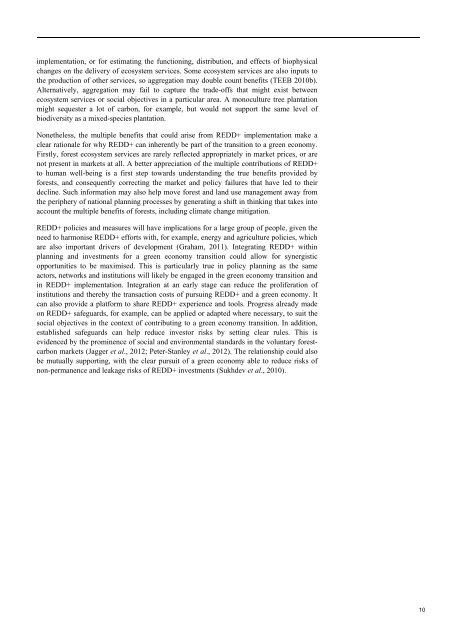integrate REDD+ into a green economy transition - Unredd.net
integrate REDD+ into a green economy transition - Unredd.net
integrate REDD+ into a green economy transition - Unredd.net
You also want an ePaper? Increase the reach of your titles
YUMPU automatically turns print PDFs into web optimized ePapers that Google loves.
implementation, or for estimating the functioning, distribution, and effects of biophysical<br />
changes on the delivery of ecosystem services. Some ecosystem services are also inputs to<br />
the production of other services, so aggregation may double count benefits (TEEB 2010b).<br />
Alternatively, aggregation may fail to capture the trade-offs that might exist between<br />
ecosystem services or social objectives in a particular area. A monoculture tree plantation<br />
might sequester a lot of carbon, for example, but would not support the same level of<br />
biodiversity as a mixed-species plantation.<br />
No<strong>net</strong>heless, the multiple benefits that could arise from <strong>REDD+</strong> implementation make a<br />
clear rationale for why <strong>REDD+</strong> can inherently be part of the <strong>transition</strong> to a <strong>green</strong> <strong>economy</strong>.<br />
Firstly, forest ecosystem services are rarely reflected appropriately in market prices, or are<br />
not present in markets at all. A better appreciation of the multiple contributions of <strong>REDD+</strong><br />
to human well-being is a first step towards understanding the true benefits provided by<br />
forests, and consequently correcting the market and policy failures that have led to their<br />
decline. Such information may also help move forest and land use management away from<br />
the periphery of national planning processes by generating a shift in thinking that takes <strong>into</strong><br />
account the multiple benefits of forests, including climate change mitigation.<br />
<strong>REDD+</strong> policies and measures will have implications for a large group of people, given the<br />
need to harmonise <strong>REDD+</strong> efforts with, for example, energy and agriculture policies, which<br />
are also important drivers of development (Graham, 2011). Integrating <strong>REDD+</strong> within<br />
planning and investments for a <strong>green</strong> <strong>economy</strong> <strong>transition</strong> could allow for synergistic<br />
opportunities to be maximised. This is particularly true in policy planning as the same<br />
actors, <strong>net</strong>works and institutions will likely be engaged in the <strong>green</strong> <strong>economy</strong> <strong>transition</strong> and<br />
in <strong>REDD+</strong> implementation. Integration at an early stage can reduce the proliferation of<br />
institutions and thereby the transaction costs of pursuing <strong>REDD+</strong> and a <strong>green</strong> <strong>economy</strong>. It<br />
can also provide a platform to share <strong>REDD+</strong> experience and tools. Progress already made<br />
on <strong>REDD+</strong> safeguards, for example, can be applied or adapted where necessary, to suit the<br />
social objectives in the context of contributing to a <strong>green</strong> <strong>economy</strong> <strong>transition</strong>. In addition,<br />
established safeguards can help reduce investor risks by setting clear rules. This is<br />
evidenced by the prominence of social and environmental standards in the voluntary forestcarbon<br />
markets (Jagger et al., 2012; Peter-Stanley et al., 2012). The relationship could also<br />
be mutually supporting, with the clear pursuit of a <strong>green</strong> <strong>economy</strong> able to reduce risks of<br />
non-permanence and leakage risks of <strong>REDD+</strong> investments (Sukhdev et al., 2010).<br />
10

















